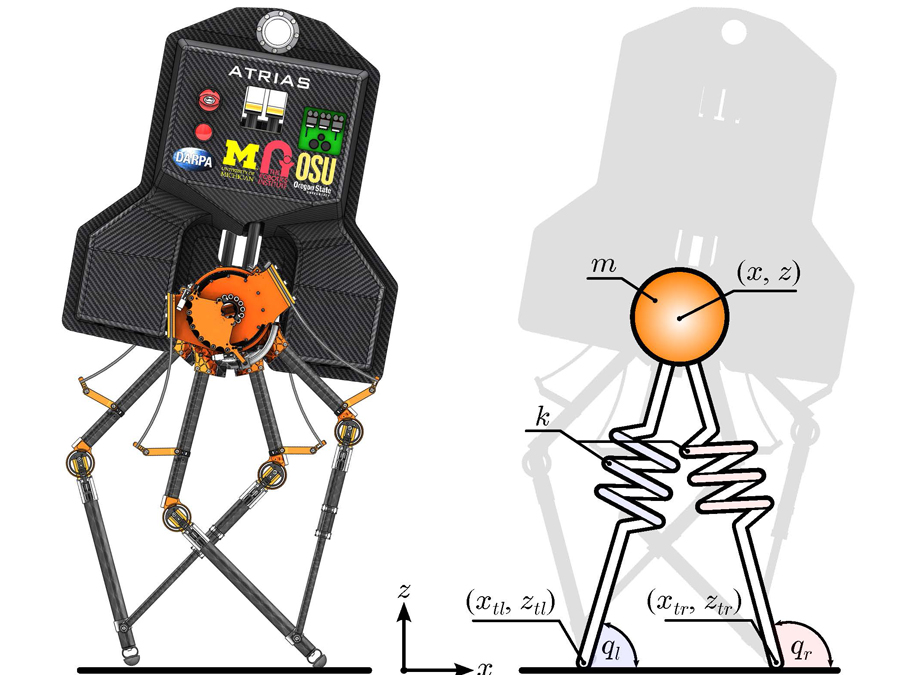Springs instead of muscles: The "ATRIAS" robot walks like a human
Robots learn to walk

When we walk, we are not consciously aware of the structure of the ground. Our body has the ability to automatically compensate for small uneven patches without tripping or coming to a standstill. Walking robots, such as the humanoid "Asimo" from Japan, closely resemble humans in appearance, but tend to walk slowly and stiffly. They also use up a lot of energy in the process.
Humans and animals do not think about walking, explains Dr. Daniel Renjewski of the Chair of Robotics and Embedded Systems at the TUM. "The intelligence lies in the mechanics." Tendons and muscles cushion the impact of any uneven patches in the ground. "When we walk, one might say that we fall from one step into the other," says Renjewski. This means that our gait is sometimes unstable. Were we to interrupt our stride in mid-movement, we would fall.
Previous walking robots: stable but stiff
This type of dynamic movement is difficult to control in a robot designed using conventional approaches. To guarantee that the machine is always stable and does not fall, the engineers therefore have to measure where the robot is located at every point in time, and how its center of gravity shifts as it moves. The price for this accurate steering is that its movements are by necessity controlled and stiff. In most cases, the machines walk on level terrain in the laboratory and are only required to avoid defined obstacles.
The goal for Renjewski and his colleagues at Oregon State University was to develop a robot whose gait is the same as that of a human. The name they gave to this robot, which they describe in a report in the journal IEEE Transactions on Robotics was "ATRIAS" (Assume The Robot Is A Sphere).
Theory and practice
The development of ATRIAS is based on the so-called spring-mass model, first presented in 1989. It describes the underlying principle of walking on two legs. In this model, the entire mass of the body is concentrated into one point, which is attached to a massless spring. The spring is a simplified representation of the muscles, bones and tendons on which the forces generated during walking act in the real world.
The researchers had to make a few more adjustments to enable them to implement this theoretical model technically: in reality, the springs also have mass, and motors are needed to compensate for unavoidable damping in the system.
Keeping steady
ATRIAS has three motors in each leg for this purpose. Two of the motors act directly on the two leg springs. The third motor ensures lateral stability. ATRIAS’s legs make up ten percent of its total mass, to get as close as possible to the theoretical lack of mass.
Trials showed that it walks three times more efficiently than other human-sized biped robots. Even outside forces, such as being hit by a ball or a rough terrain, cannot unbalance it. Prof. Jonathan Hurst of Oregon State University, and the initiator of the study, is sure that this type of locomotion will catch on in walking robots of the future. If the technology is improved even further, these robots could, for instance, be used to assist firefighting.
Better prostheses
However, these research results are also meaningful for people. In the next research step, Renjewski, who moved to the TUM in May of this year, is working on transferring these findings to robots for gait rehabilitation and prostheses.
Original publication: Daniel Renjewski, Alexander Sprowitz, Andrew Peekema, Mikhail Jones, Jonathan Hurst: "Exciting Engineered Passive Dynamics in a Bipedal Robot"; IEEE Transactions on Robotics, Volume 31, Issue 5; DOI: 10.1109/TRO.2015.2473456
The work was supported by the National Science Foundation, the Defense Advanced Research Projects Agency and the Human Frontier Science Program.
Photo to download: flic.kr/p/s6hFdj
YouTube video: www.youtube.com/watch;
Technical University of Munich
Corporate Communications Center
- Stefanie Reiffert
- reiffert@zv.tum.de
- presse@tum.de
- Teamwebsite
Contacts to this article:
Dr. Daniel Renjewski
Technical University of Munich (TUM)
Chair of Robotics and Embedded Systems (Prof. Alois Knoll)
+49 (0)89 289 18133
daniel.renjewski@tum.de
Prof. Jonathan Hurst
Oregon State University
Associate Professor of Mechanical Engineering
+1-541-737-7010
jonathan.hurst@oregonstate.edu